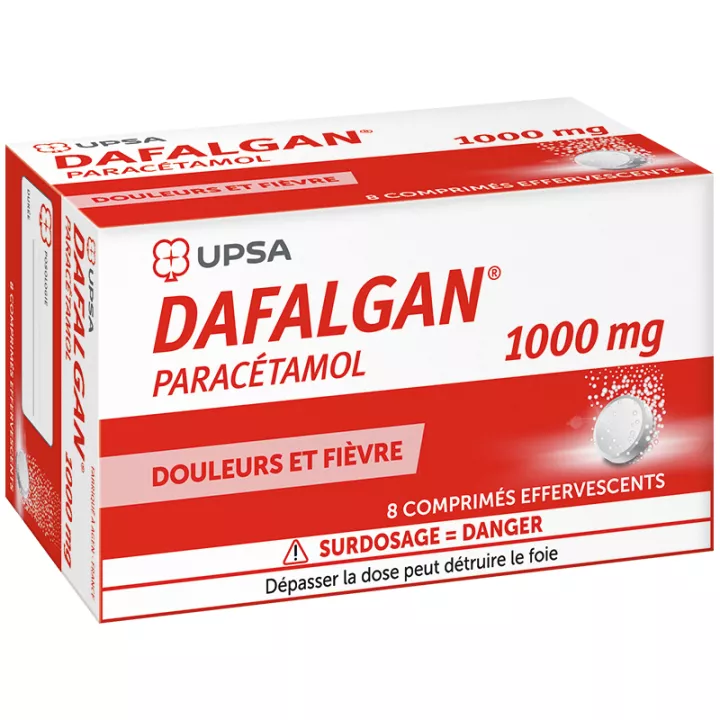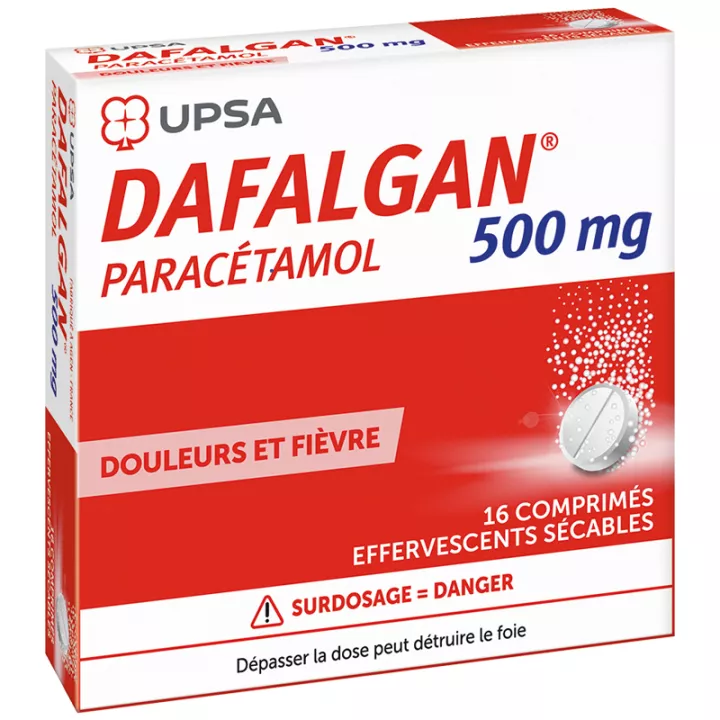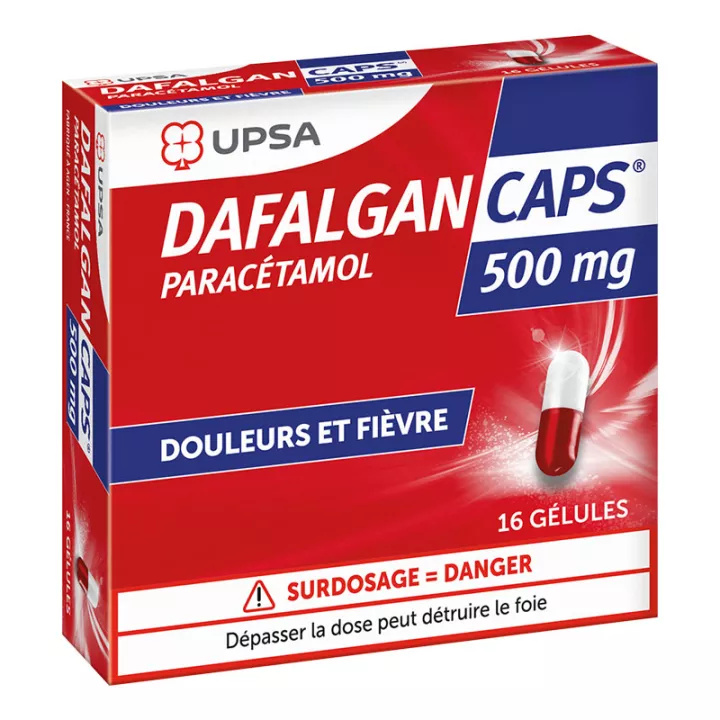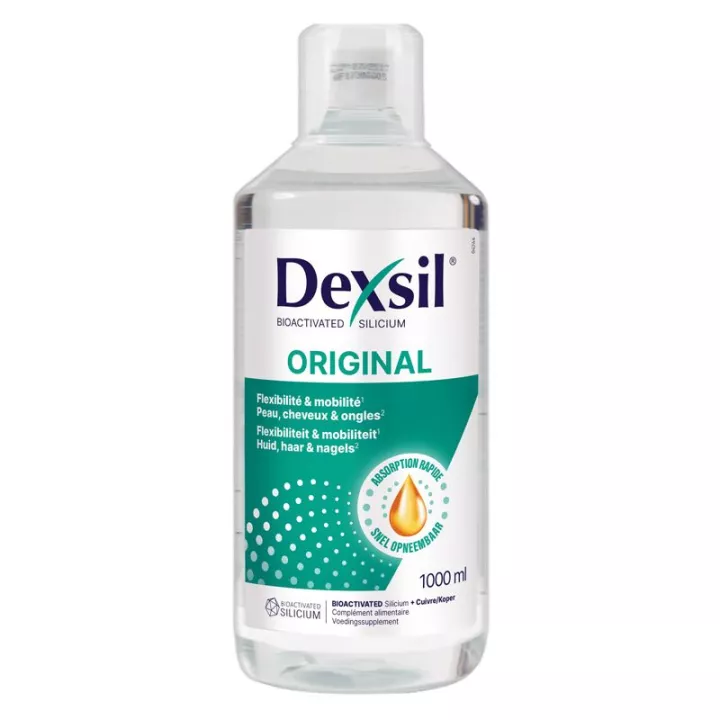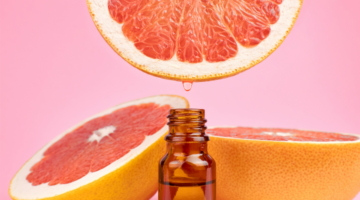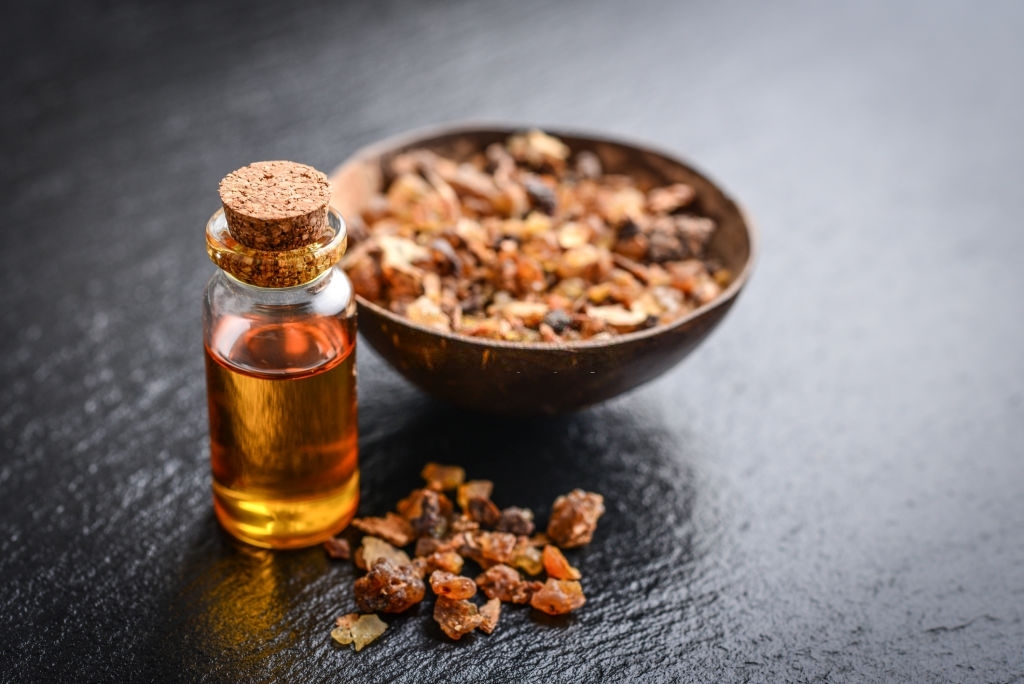NOTICE
ANSM - Last updated: 30/06/2017
Name of the medicinal product
DAFALGAN 1000 mg, effervescent tablet
Paracetamol
framed
Please read this leaflet carefully before you start taking this medicine because it contains important information for you.
You should always take this medication exactly as prescribed in this leaflet or by your doctor, pharmacist or nurse.
· Keep this leaflet. You might need to read it again.
· Ask your pharmacist for advice or information.
· If you experience any side effects, talk to your doctor, pharmacist or nurse. This also applies to any side effects not mentioned in this leaflet. See section 4.
· You should contact your doctor if you experience no improvement or feel less well after 3 days in case of fever or 5 days in case of pain.
What is in this leaflet?
1. What is DAFALGAN 1000 mg , effervescent tablet and in which cases it is used?
2. What should I know before taking DAFALGAN 1000 mg , effervescent tablet?
3. How to take DAFALGAN 1000 mg , effervescent tablet?
4. What are the possible side effects?
5. How to store DAFALGAN 1000 mg , effervescent tablet?
6. Package contents and other information.
1. WHAT IS DAFALGAN 1000 mg, effervescent tablet AND IN WHAT CASES IS IT USED?
Pharmacotherapeutic group: OTHER ANTALGS AND ANTIPYRETICS-ANILIDES - ATC code: N02BE01.
This medication contains paracetamol: an analgesic (it calms the pain) and an antipyretic (it lowers the fever).
It is indicated for pain and / or fever such as headaches, flu-like conditions, dental pain, muscle aches, painful periods.
This presentation is reserved for the adult and the child from 50 kg (from about 15 years) : read carefully the Dosage section .
For children of different weights, other forms of paracetamol are available: ask your doctor or pharmacist for advice.
You should contact your doctor if you experience no improvement or feel less well after 3 days, in case of fever or 5 days in case of pain.
2. BEFORE YOU TAKE DAFALGAN 1000 mg, effervescent tablet?
Do not take DAFALGAN 1000 mg, effervescent tablet:
· If you are allergic to the active substance or to any of the other ingredients of this medication mentioned in section 6.
· If you have severe liver disease.
· If you are a child under 15 years old.
· In case of phenylketonuria (hereditary disease detected at birth), due to the presence of aspartame.
IN CASE OF DOUBT, IT IS ESSENTIAL TO ASK FOR THE OPINION OF YOUR DOCTOR OR YOUR PHARMACIST.
Warnings and Precautions
Talk to your doctor or pharmacist before taking DAFALGAN 1000 mg, effervescent tablet.
In case of overdosage or mistake of too high a dose, consult your doctor immediately.
This medicinal product contains paracetamol. Other medicines contain it.
Make sure you do not take any other medicines containing paracetamol, including medicines obtained without a prescription.
Do not combine them, so as not to exceed the recommended daily dose.
(see "Posology" and "Symptoms and Instructions for Overdose").
· If the pain persists more than 5 days or the fever more than 3 days , or if there is insufficient efficacy or any other signs, do not continue treatment without the advice of your doctor.
· Before starting treatment with this drug, check that you are not taking any other medicines containing paracetamol.
Tell your doctor before you take this medicine if any of the following apply to you:
· If you are adult and you weigh less than 50 kg,
· If you are taking other medicines containing paracetamol (medicines obtained with or without a prescription),
· If you have liver or kidney disease,
· If you have Gilbert's syndrome (non-haemolytic familial jaundice),
· Or alcohol abuse (excessive alcohol consumption (3 or more alcoholic beverages per day)),
· If you suffer from glucose-6-phosphate dehydrogenase (G6PD) deficiency (which can lead to hemolytic anemia),
· If you have problems with nutrition (malnutrition (low reserves of hepatic glutathione), anorexia, bulimia or cachexia (heavy weight loss)
· If you have problems with dehydration, hypovolemia (significant loss of body water).
The use of this medication is not recommended in patients with galactose intolerance, Lapp lactase deficiency or glucose or galactose malabsorption syndrome (rare hereditary diseases).
This medicine contains sodium. This medicine contains 370 mg of sodium per tablet. To be taken into account in patients controlling their sodium dietary intake.
The use of this medication is not recommended in patients with fructose intolerance (rare hereditary disease).
If you have acute viral hepatitis or if you have an acute viral hepatitis during your treatment with DAFALGAN 1000 mg effervescent tablet, talk to your doctor. Your treatment may be suspended by your doctor.
IN CASE OF DOUBT, DO NOT HESITATE TO ASK FOR THE OPINION OF YOUR DOCTOR OR YOUR PHARMACIST.
Children and Youth
In a child treated with paracetamol, the association of another antipyretic is justified only in case of ineffectiveness. The association should be established and monitored only by a physician.
Other medicines and DAFALGAN 1000 mg, effervescent tablet
Inform your doctor or pharmacist if you are taking, have recently taken or may take any other medicines.
In case of concomitant treatment with probenecid, a dose reduction of DAFALGAN 1000 mg, effervescent tablet should be considered.
You should contact your doctor if you are taking medication that slows down coagulation (oral anticoagulants). In high doses, DAFALGAN 1000 mg, effervescent tablet can increase the action of your anticoagulant. If necessary, your doctor will adjust the dosage of your anticoagulant.
Inform your doctor or pharmacist if you are taking phenytoin, the simultaneous use of these drugs and paracetamol may damage the liver.
Inform your doctor or pharmacist if you are taking enzyme inducers (such as phenobarbital, carbamazepine, primidone, rifampicin).
Tell your doctor or prescriber about all prescription and nonprescription / herbal products you may use before using this medication.
DAFALGAN 1000 mg, effervescent tablet with food, drink and alcohol
Not applicable.
Pregnancy, breast-feeding and fertility
If you are pregnant or breastfeeding, think you may be pregnant or plan a pregnancy, ask your doctor or pharmacist for advice before taking this medicine.
Pregnancy and breast feeding
This medicine may be used during pregnancy and lactation. Use the lowest dose to reduce your pain and / or fever for as short a time as possible and as often as possible. Contact your doctor or midwife if pain and / or fever does not decrease or if you need to take this medication more frequently during your pregnancy.
Fertility
It is possible that paracetamol may alter the fertility of women, reversibly upon discontinuation of therapy.
Driving and using machines
Paracetamol has no or negligible effect on the ability to drive and use machines.
DAFALGAN 1000 mg, effervescent tablet contains sodium (370 mg per tablet), sorbitol (E420), aspartame (E951) and lactose.
3. HOW TO TAKE DAFALGAN 1000 mg, effervescent tablet?
Always take this medication exactly as prescribed in this leaflet or as directed by your doctor, pharmacist or nurse. Check with your doctor, pharmacist or nurse if in doubt.
CAUTION: This tablet contains 1000 mg (1 g) of paracetamol per tablet: do not take 2 tablets at a time .
Dosage
This presentation is reserved for adults and children from 50 kg (from about 15 years).
Weight (Age) | Dose per administration | Interval of administration | Maximum Daily Dose |
Adults and children from 50 kg (from about 15 years old) | 1000 mg
(1 tablet) | 4 hours minimum | 3000 mg (3 tablets) |
It is generally not necessary to exceed 3 g of paracetamol per day, ie 3 tablets per day.
However, in case of more intense pain, and on advice from your doctor, the total dose can be increased up to 4 g per day, or 4 tablets per day.
However,
· doses greater than 3 g of paracetamol per day require medical advice.
· NEVER TAKE MORE THAN 4 GRAMS OF PARACETAMOL PER DAY (taking all medicines containing paracetamol into their formula).
Always respect an interval of at least 4 hours between the catches.
The maximum daily dose shall not exceed 60 mg / kg (not to exceed 3 g) per day in the following situations:
· adults less than 50 kg ,
· severe liver damage,
· Gilbert syndrome (non-hemolytic familial jaundice),
· chronic alcoholism,
· chronic malnutrition,
· dehydration.
If you feel that the effect of DAFALGAN 1000 mg, effervescent tablet is too strong or too weak, talk to your doctor or pharmacist.
IN CASE OF DOUBT, ASK FOR ADVICE TO YOUR DOCTOR OR YOUR PHARMACIST.
Method and route of administration
Oral use.
Allow the tablet to dissolve completely in a glass of water.
Do not swallow or chew the tablets.
In addition, if your child has a fever greater than 38.5 ° C, you can improve the effectiveness of the drug treatment by:
· discover your child,
· make the drink,
· do not leave your child in a place too hot.
Frequency of Administration
Systematic catches help to avoid oscillations of pain or fever.
· In adults and children over 15 years of age, they must be spaced at least 4 hours apart.
Renal failure
In case of kidney disease (kidney failure), the minimum interval between 2 doses should be modified according to your renal function according to the following table:
Creatinine clearance | Interval of administration |
cl ≥ 50 mL / min | 4 hours |
cl 10-50 mL / min | 6 hours |
cl <10 mL / min | 8 hours |
The total dose of paracetamol should not exceed 3 g / day, ie 3 tablets.
Duration of treatment
The duration of treatment is limited:
· to 5 days in case of pain,
· at 3 days in case of fever.
If the pain persists more than 5 days or the fever more than 3 days, if they worsen, do not continue treatment without the advice of your doctor or pharmacist.
If you take more DAFALGAN 1000 mg, effervescent tablet than you should
In case of overdose or accidental poisoning, notify a doctor immediately.
If you forget to take DAFALGAN 1000 mg, effervescent tablet
Do not take a double dose to make up for a missed dose.
If you stop taking DAFALGAN 1000 mg, effervescent tablet
Not applicable.
4. WHAT ARE POSSIBLE SIDE EFFECTS?
Like all medicines, this medicine may cause side effects, although not everybody gets them.
· In some rare cases, it is possible that a rash or reddening or allergic reaction can occur, which can be manifested by a sudden swelling of the face and neck or by a sudden discomfort with drop in blood pressure. Immediately stop treatment , tell your doctor and never take any medicines containing paracetamol.
· In some rare cases, severe skin reactions have been reported. Immediately stop treatment, tell your doctor and never take any medicines containing paracetamol.
· Exceptionally, biological changes requiring blood check have been observed: liver function disorders, abnormally low levels of certain white blood cells or certain blood cells such as platelets which can result in nosebleeds or gums. In this case, consult a doctor.
· Cases of diarrhea, abdominal pain, increased liver enzymes, increased or decreased INR have been reported.
Declaration of side effects
If you experience any side effects, talk to your doctor, pharmacist or nurse. This also applies to any side effects not mentioned in this leaflet. You can also report adverse reactions directly via the national reporting system: National Agency for the Safety of Medicines and Health Products (ANSM) and network of Regional Centers of Pharmacovigilance - Website: www.ansm.sante.fr
By reporting adverse reactions, you are helping to provide more information about the safety of the drug.
5. HOW TO STORE DAFALGAN 1000 mg, effervescent tablet?
Keep this medicine out of the reach and sight of children.
Do not use this medicine after the expiry date which is stated on the package. The expiry date refers to the last day of that month.
Store at a temperature not exceeding 25 ° C.
Do not throw any medicines into drains or rubbish. Ask your pharmacist to remove any medications you are no longer using. These measures will help protect the environment.
6. PACKAGE CONTENTS AND OTHER INFORMATION
What DAFALGAN 1000 mg contains, effervescent tablet
· The active substance is:
Paracetamol................................................. .................................................. .............. 1000 mg
For an effervescent tablet.
· The other components are:
Anhydrous citric acid, sodium bicarbonate, anhydrous sodium carbonate, sorbitol, sodium docusate, povidone, sodium benzoate, anhydrous lactose, orange / grapefruit flavoring, aspartame, acesulfame potassium.
What is DAFALGAN 1000 mg, effervescent tablet and contents of the pack
This medication is in the form of an effervescent tablet.
Box of 8 tablets.
Marketing Authorization Holder
UPSA SAS
3, RUE JOSEPH MONIER
92500 RUEIL-MALMAISON
Marketing Authorization Operator
UPSA SAS
3, RUE JOSEPH MONIER
92500 RUEIL-MALMAISON
Maker
UPSA SAS
304, avenue du docteur jeaN bru
47000 agen
or
UPSA SAS
979, AVENUE DES PYRENEES
47520 THE PASSAGE
Names of the medicinal product in the Member States of the European Economic Area
Not applicable.
The last date on which this leaflet was revised is:
[to be completed later by the holder]
{month YYYY}.
Other
Detailed information on this medicine is available on the ANSM website (France).
Health Education Council:
WHAT TO DO IN CASE OF FEVER:
The normal temperature of the body varies from person to person and is between 36.5 ° C and 37.5 ° C. A rise in temperature above 38 ° C may be considered a fever.
This medication is intended for adults and children from 50 kg (from about 15 years).
If the disorders that the fever causes are too troublesome, you can take this drug that contains paracetamol in accordance with the indicated dosages.
To avoid any risk of dehydration, consider drinking frequently.
With this medication, the fever should drop rapidly. However :
· if other unusual signs appear,
· if the fever persists for more than 3 days or if it worsens,
· if the headache becomes violent, or in case of vomiting.
CONSULT YOUR DOCTOR IMMEDIATELY.
WHAT TO DO IF PAIN:
The intensity of the perception of pain and the ability to resist it vary from person to person.
· If there is no improvement after 5 days of treatment,
· if the pain is violent, unexpected and occurs suddenly (including severe pain in the chest) and / or reverses regularly,
· if accompanied by other signs such as general malaise, fever, unusual swelling of the painful area, decreased strength in a limb,
· if it wakes you up at night.
CONSULT YOUR DOCTOR IMMEDIATELY.

